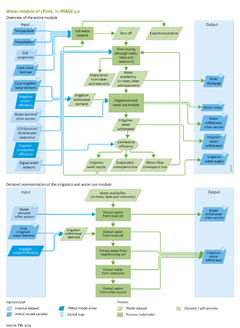Water/Description: Difference between revisions
< Water
Jump to navigation
Jump to search
No edit summary |
No edit summary |
||
| Line 5: | Line 5: | ||
==The ‘natural’ hydrological cycle== | ==The ‘natural’ hydrological cycle== | ||
The hydrological module in the LPJmL model consists of a vertical water balance ([[Gerten et al., 2004]]) and a lateral flow component ([[Rost et al., 2008]]) ( | The hydrological module in the LPJmL model consists of a vertical water balance ([[Gerten et al., 2004]]) and a lateral flow component ([[Rost et al., 2008]]) (see flowchart I on the right), which are run at 0.5 degree resolution in time steps of one day. The soil in each grid cell is represented by a two-layer soil column of 0.5 and 1 metre depth, respectively, partly covered with natural vegetation or crops. | ||
The potential evaporation rate in each grid cell depends primarily on net radiation and temperature, and is calculated using the Priestley-Taylor approach ([[Gerten et al., 2004]]). The actual evapotranspiration is calculated as the sum of three components: evaporation of intercepted precipitation, bare soil evaporation and plant transpiration. ([[Gerten et al., 2004]]). | The potential evaporation rate in each grid cell depends primarily on net radiation and temperature, and is calculated using the Priestley-Taylor approach ([[Gerten et al., 2004]]). The actual evapotranspiration is calculated as the sum of three components: evaporation of intercepted precipitation, bare soil evaporation and plant transpiration. ([[Gerten et al., 2004]]). | ||
The water storage in the canopy is a function of vegetation type, leaf area index ([[HasAcronym::LAI]]) and precipitation amount. Interception evaporation occurs at potential evaporation rate, during the fraction of the daytime that the canopy is wet. | The water storage in the canopy is a function of vegetation type, leaf area index ([[HasAcronym::LAI]]) and precipitation amount. Interception evaporation occurs at potential evaporation rate, during the fraction of the daytime that the canopy is wet. | ||
| Line 19: | Line 19: | ||
===Irrigation and demand for irrigation water=== | ===Irrigation and demand for irrigation water=== | ||
To simulate water availability and demand related to agriculture, the LPJmL model includes an irrigation algorithm ([[Rost et al., 2008]]) and one that simulates the operation of large reservoirs to supply water to irrigated areas ([[Biemans et al., 2011]]). | To simulate water availability and demand related to agriculture, the LPJmL model includes an irrigation algorithm ([[Rost et al., 2008]]) and one that simulates the operation of large reservoirs to supply water to irrigated areas ([[Biemans et al., 2011]]). | ||
The irrigation demand module ( | The irrigation demand module (see flowchart II on the right) is described in detail by [[Rost et al., 2008]]. The crop irrigation demand for an irrigated crop is defined as the minimum of atmospheric evaporative demand and the amount of water needed to fill up the soil to field capacity. The irrigation withdrawal demand is subsequently calculated as the product of the crop irrigation demand and a country-specific irrigation efficiency factor that reflects the type of irrigation system ([[Rost et al., 2008]]). Irrigation water is extracted from the rivers and lakes in the grid cell or a neighbouring grid cell. If those local surface water sources cannot satisfy the total demand, water will be extracted from nearby reservoirs, if available. Finally, water can be supplied from an unlimited source of water that can be interpreted as non-sustainable groundwater or water imported from another basin. | ||
By subsequently excluding these water sources in a series of model runs, it is possible to attribute irrigation water supply and crop production to different sources of water. | By subsequently excluding these water sources in a series of model runs, it is possible to attribute irrigation water supply and crop production to different sources of water. | ||
Some of the water withdrawn for irrigation is lost during transport from withdrawal point to irrigated field. The magnitude of these losses depends on the type of conveyance system (e.g. open channel or pipeline) and is determined using a country-specific conveyance efficiency factor ([[Rost et al., 2008]]). Therefore, the amount of water applied to a field is always lower than the amount of water withdrawn, but in case of no water stress, still higher than the crop irrigation demand. | Some of the water withdrawn for irrigation is lost during transport from withdrawal point to irrigated field. The magnitude of these losses depends on the type of conveyance system (e.g. open channel or pipeline) and is determined using a country-specific conveyance efficiency factor ([[Rost et al., 2008]]). Therefore, the amount of water applied to a field is always lower than the amount of water withdrawn, but in case of no water stress, still higher than the crop irrigation demand. | ||
Revision as of 12:37, 10 December 2013
Parts of Water/Description
| Component is implemented in: |
|
| Related IMAGE components |
| Projects/Applications |
| Key publications |
| References |
